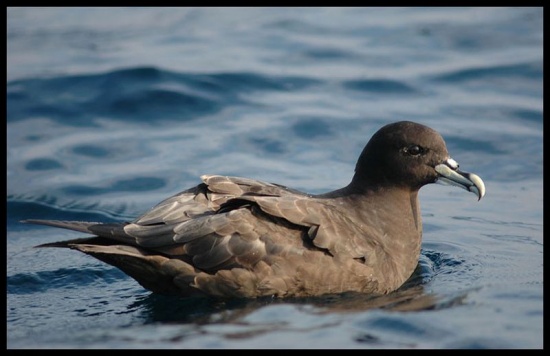(taxonomy, format, ref) |
(Spectacled petrel, range, refs) |
||
| Line 9: | Line 9: | ||
55 cm in length. 147 cm in wingspan. | 55 cm in length. 147 cm in wingspan. | ||
| + | |||
| + | ====Spectacled Petrel==== | ||
| + | The subspecies ''conspicillata'' has a white ring going from the rear end of the forehead down almost to the bill, and from there below the auriculars before turning up to the rear of the crown. On at least some birds, there is a continuation from the lowest, foremost point going down below the chin which is actually black in this subspecies. The rest of the body looks very dark on photos. Bill is pale with slightly darker tip. | ||
==Distribution== | ==Distribution== | ||
| − | [[South Australia]], [[Peru]] and [[Namibia]]; breeds colonially on [[South Georgia]], [[Prince Edward Islands]], [[Crozet Islands]], [[Kerguelen Islands]], [[Auckland Island]], [[Campbell Island]] and [[Antipodes Islands]]. | + | Subspecies ''aequinoctialis'': [[South Australia]], [[Peru]] and [[Namibia]]; breeds colonially on [[South Georgia]], [[Prince Edward Islands]], [[Crozet Islands]], [[Kerguelen Islands]], [[Auckland Island]], [[Campbell Island]] and [[Antipodes Islands]], all islands situated in cold water areas. <br /> |
| − | + | Subspecies ''conspicillata'': only known to occur on Inaccessible Island in the [[Tristan da Cunha]] group. Feeding areas include areas near the coast of [[Brazil]] but mainly out in open sea<sup>[[#References|[2]]]</sup>. | |
==Taxonomy== | ==Taxonomy== | ||
| − | Two subspecies are recognized: | + | Two subspecies are recognized<sup>[[#References|[1]]]</sup>: |
*''P.a. aequinoctialis'' - circumpolar breeding on subantarctic islands | *''P.a. aequinoctialis'' - circumpolar breeding on subantarctic islands | ||
*''P.a. conspicillata'' - Inaccessible Island | *''P.a. conspicillata'' - Inaccessible Island | ||
| Line 25: | Line 28: | ||
The diet includes krill. | The diet includes krill. | ||
==References== | ==References== | ||
| − | #{{Ref-Clements6thDec09}} | + | #{{Ref-Clements6thDec09}}#[http://www.wildlifeextra.com/go/news/spectacled-petrel009.html#cr Story] about the satellite tagging of five Spectacled Petrels |
==External Links== | ==External Links== | ||
{{GSearch|Procellaria+aequinoctialis}} | {{GSearch|Procellaria+aequinoctialis}} | ||
*[http://www.aviceda.org/abid/birdimages.php?action=birdspecies&fid=56&bid=712 View more images of this species on the ABID] | *[http://www.aviceda.org/abid/birdimages.php?action=birdspecies&fid=56&bid=712 View more images of this species on the ABID] | ||
[[Category:Birds]][[Category:Procellaria]] | [[Category:Birds]][[Category:Procellaria]] | ||
Revision as of 01:10, 8 May 2010
Includes Spectacled Petrel
- Procellaria aequinoctialis
Identification
There is a thread discussing the identification of White-chinned Petrel and confusion species.[[1]]
55 cm in length. 147 cm in wingspan.
Spectacled Petrel
The subspecies conspicillata has a white ring going from the rear end of the forehead down almost to the bill, and from there below the auriculars before turning up to the rear of the crown. On at least some birds, there is a continuation from the lowest, foremost point going down below the chin which is actually black in this subspecies. The rest of the body looks very dark on photos. Bill is pale with slightly darker tip.
Distribution
Subspecies aequinoctialis: South Australia, Peru and Namibia; breeds colonially on South Georgia, Prince Edward Islands, Crozet Islands, Kerguelen Islands, Auckland Island, Campbell Island and Antipodes Islands, all islands situated in cold water areas.
Subspecies conspicillata: only known to occur on Inaccessible Island in the Tristan da Cunha group. Feeding areas include areas near the coast of Brazil but mainly out in open sea[2].
Taxonomy
Two subspecies are recognized[1]:
- P.a. aequinoctialis - circumpolar breeding on subantarctic islands
- P.a. conspicillata - Inaccessible Island
Status of Spectacled Petrel conspicillata
Recently, the SACC (2008) passed a proposal to separate conspicillata as a full species, citing vocal differences noted by Ryan (1998). However, it is treated as a subspecies of aequinoctialis by most authorities (Howard & Moore, 2003; Sibley & Monroe, 1996), and the Opus follows this consensus.
Habitat
Open sea except when breeding.
Behaviour
The diet includes krill.
References
- Clements, JF. 2009. The Clements Checklist of Birds of the World. 6th ed., with updates to December 2009. Ithaca: Cornell Univ. Press. ISBN 978-0801445019.
- Story about the satellite tagging of five Spectacled Petrels




